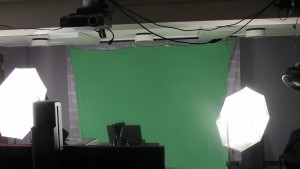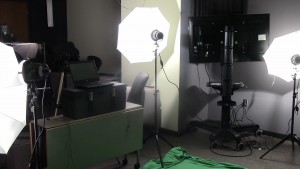In the latest installment of “how-to” (or at least “think about this”) posts about filming your own mini lectures, I discuss the wonderful world of green screens. We have all seen this. Every weather reporter stares at a green (or sometimes blue) screen while using off-camera monitors as guidance. That big weather map behind her: there is nothing there except a blank green screen. This presents those of us making videos with a wonderful opportunity to project an image or images onto a background and then layer live footage or text on top. But there are some things you need to consider before using a green screen. Continue reading
Tag: video production
So, if you have been following the blog you now have had a glimpse behind the scenes and read about why I initiated this project. Hopefully you have watched a few of our videos by now. If you haven’t, please do so before reading this blog post.
Welcome back. So, you watched a few videos and thought, “Wow! How did they do that.” Ok, perhaps you said, “Meh…” but are still interested in our process. Aleks and I will walk you through a video from start to finish. We really had no fancy equipment; only what we could get at our media center on campus. You’ll see in the images that we worked in about half of a small room that served as our studio and then edited in a old closet.
What kind of experience did we have coming into this project? Karl has conducted some oral histories and edited in iMovie (he hates Apple products, but iMovie is far superior to Windows Movie Maker). During the year Aleks works at the Clarke Forum for Contemporary Issues where she regularly uses software such as PhotoShop, InDesign, iMovie, and Audacity to create visuals and edit interviews. Because Aleks knew more of the editing tech than Karl, in most cases we divided the labor. Karl came up with ideas and wrote scripts; Aleks filmed and edited it all. There are some exceptions which we will discuss at a later time.
First thing you should know: Continue reading
Welcome back to my long-dormant teaching blog. I’ve been teaching a lot, just not blogging about it.
During summer 2016, however, I tried something quite different and thought that I would blog about it. With the superb assistance of a rising junior, Aleksandra Syniec, we have put together video mini-lectures for several of my classes. This is not a MOOC! The hard intellectual work is always done in concert with an instructor and peers. Some might call this “flipping the classroom,” but isn’t that what we always do anyway? Students read/watch/listen before class, and then we talk about it. I teach at a small liberal arts school, so talk-and-chalk is unnecessary. My role is not information transmission; my job is to teach critical thinking and communication.
My intent in our “Time Capsules” videos was to experiment with topics and forms, assess student learning, and ask students to evaluate the videos so that I know if the tremendous investment in time is worth it. My objectives were to 1) replicate the overview that students might get from textbooks (but I never assign textbooks; they just aren’t challenging enough for my students and they are unnecessarily costly), 2) free up time in class to discuss our primary and secondary sources, 3) provide some skill development for one of my students, and 4) allow students with certain learning challenges to start, stop, and rewatch rather than struggling with the manic pace of most of my in-class lectures. I’m certain that the videos will be helpful for #4. Aleks has already commented on how valuable it was to her as a student to collaborate on this project.
I’m not sure what to expect for the first two goals. Because these are very short videos, all under 15 minutes, I cannot possibly replicate the amount of information covered in a textbook chapter, but that is not my intention. I am covering smaller parts of one topic. For example, whereas a textbook might have a chapter on World War I, I have elected to just talk about the development of alliances on the video. In class we will cover propaganda, the technologies of war, home front and frontline, etc.
I expect that I will save time in class. For the industrial revolution video, for example, the video is about half the time as similar material I would cover in class. Unless students arrive in class with a lot of questions from the video, there should be a good time savings.
I will be adding new blog posts regularly in the coming weeks. Until then, check out our YouTube channel at: https://youtube.com/c/KarlQuallsTimeCapsules. Like us, and make sure to subscribe so that you get notices as we put up new videos. Follow this blog for updates, and please share with your friends and share your ideas. For ASEEES colleagues, contact me if you are interested in discussing presentations on alternative pedagogies.
The Teaching History blog is now officially up and running again. For my first post of the upcoming academic year, I want to show you what we have been doing this summer. The Digital Humanities Advisory Committee at Dickinson College was gracious enough to provide funding for a student-faculty collaboration for eight weeks. I hired one of my students to help make 9 mini-lecture videos that will help set the stage for certain classes in a variety of courses. You can watch all of the videos on our YouTube Time Capusules site; I have embedded our “Behind the Scenes” report below in which we provide an overview of the project and discuss the benefits of student faculty collaboration. Enjoy!
[youtube_sc url=”https://youtu.be/wx7HC0z0IV8″ title=”Behind%20the%20Scenes%20at%20T%20ime%20Capsules”]
During the coming months, I will be writing short posts on the ins and outs of creating videos. These will be neither prescriptive nor proscriptive and certainly not “best practices” (how I loathe that term). We will simply walk you through what we did and then you can decide what might work best for you.

